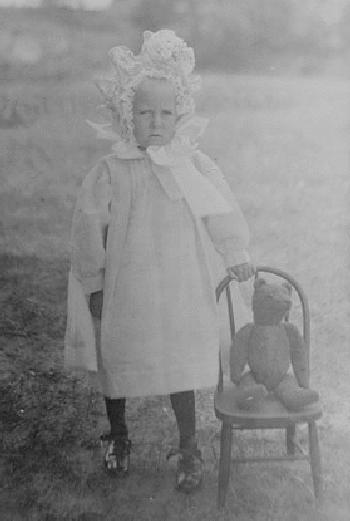
Boys' Baby Bonnets and Caps

Figure 1.--Baby bonnets could be a bit elaborate and large in the late 19th and early 20 century. This looks to be a boy wearing his baby bonnet and smock. He also wears long black stockings and strap shoes with bows. HBC estimates that the photograph was taken about 1905. He does not look too pleased with his bonnet. Click on the image for a close up.
|
Caps and bonnets were a common part of a baby's outfit through the 1920s. They were worn throughtout the day, inside and outside. Some children wore two caps. The first might be a plain cap made out of cotton and wool. The second was usually more ornamental--sometimes lavishly trimmed with ruffles and lace, quilted, emroidered, or decorated with
other decorative embelishments. Especially elaborate caps were worn for christenings. They were most commonly white, but like the outer cloak could be colored and cembroidered. Padded caps during the 18th and early 19th Century were sometimes used to help shape a baby's head, especially if it was judged to be pointed. These paded caps were used even longer to protect a baby's head from injury as a result of a fall. These caps were known as pudding caps. (Pudding at the time not only had the modern connotation, but also meant a stuffed sausage. It was also another word for dumb.) A common expression at the time was that you wore a pudding cap so your brains wouldn't turn into pudding.
Bonnets
The word bonnet has been used to decribe many kinds of cap-like headwear. In Scotland it is a kind of brimless cap worn by men or boys, the Tam O'Shanter. The word "bonnet" is more commonly used to a clth or straw hat usually tied under the chin and worn by women or younger children.
Caps and bonnets were a common part of a baby's outfit through the 1920s. They were worn throughtout the day, inside and outside. Some children wore two caps. The first might be a plain cap made out of cotton and wool. The second was usually more ornamental--sometimes lavishly trimmed with ruffles and lace, quilted, emroidered, or decorated with
other decorative embelishments. Especially elaborate caps were worn for christenings. They were most commonly white, but like the outer cloak could be colored and cembroidered. While these bonnets were normally worn by quite young children--usually infants, we have occasionally seen somewhat older children wearing them. Usually the older children are girls, but not always.
Padded caps during the 18th and early 19th Century were sometimes used to help shape a baby's head, especially if it was judged to be pointed. These paded caps were used even longer to protect a baby's head from injury as a result of a fall. These caps were known as pudding caps. (Pudding at the time not only had the modern connotation, but also meant a stuffed sausage. It was also another word for dumb.) A common expression at the time was that you wore a pudding cap so your brains wouldn't turn into pudding.
Bourrelet
While English babies in the 18th century often wore padded caps called puddin or pudding capsto protect a baby's head from a fall. French mothers in the 18th century used a bourrelet which seems
to have had a similar purpose, but were not as well padded.
Christopher Wagner

Navigate the Historic Boys' Clothing Web Headwear Pages:
[Return to the Main cap page]
[Return to the Main infant page]
[Return to the Main headwear page]
[Caps]
[Hats]
[Berets]
[Hair]
Navigate the Historic Boys' Clothing Web chronological pages:
[The 1880s]
[The 1890s]
[The 1900s]
[The 1910s]
[The 1920s]
[The 1930s]
[The 1940s]
[The 1950s]
[The 1960s]
[The 1970s]
[The 1980s]
Navigate the Historic Boys' Clothing Web Site:
[Introduction]
[Activities]
[Biographies]
[Chronologies]
[Countries]
[Style Index]
[Bibliographies]
[Contributions]
[Expanded Site]
[Frequently Asked Questions]
[Glossaries]
[Satellite sites]
[Tools]
[Boys' Clothing Home]
Created: November 28, 2001
Last updated: July 18, 2003



